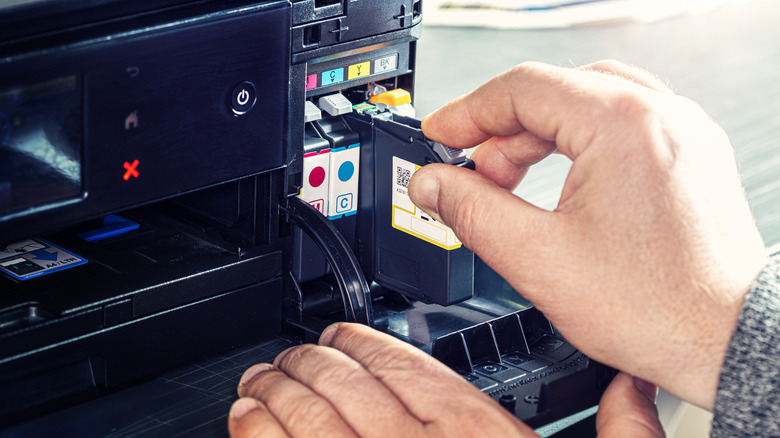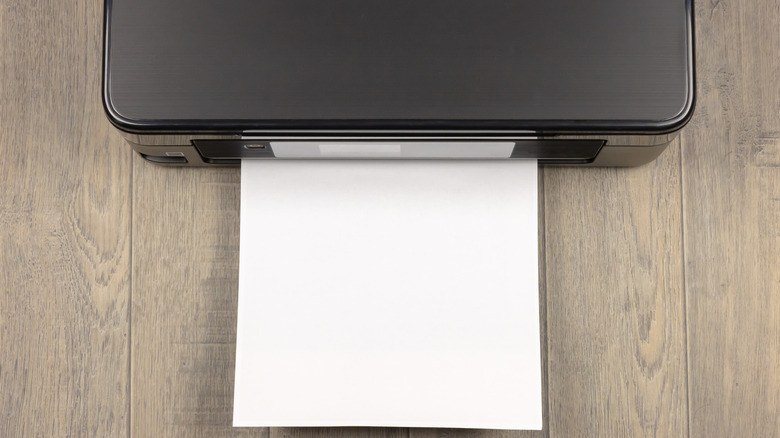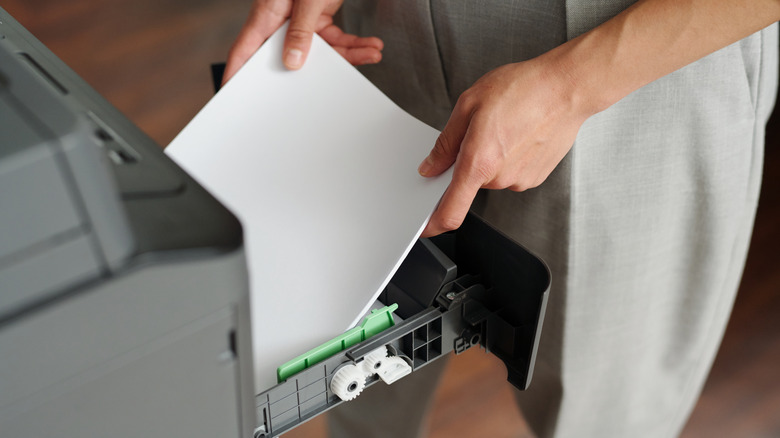What To Check For If Your Printer Is Printing Blank Pages
Is there any more frustrating gadget than a printer? You'd think that a product which has existed since the dawn of the computer age would get better with time, but even in 2024 they always seem to go haywire for no clear reason. Something about the combination of software and intricate moving parts inside those infernal machines creates a perfect storm of problems that can be extremely difficult to troubleshoot. It's bad enough when a printer won't print, but what do you do when your printer is spitting out blank pages?
There are a variety of reasons why a printer might start printing blank pages, and some are easier to fix than others. To be clear, we're talking here about a standard paper printer that is printing completely white pages. The cause for this problem can vary from issues with your ink cartridges to software problems that prevent print instructions from reaching the machine. While some major printer brands are better than others, all seem to suffer from blank page printing from time to time, even if you're using one of the best printers for a home office or workplace. After checking the potential reasons for this problem below, you'll be back to printing as usual in no time.
Check your ink and toner cartridges
Let's start with the most obvious explanation for blank pages being printed. It's of course possible that your ink cartridges are depleted. Most printers will do their best to let you know when the ink runs out, but not all, and in some cases the printer may not know it's out of ink. You can check the ink levels by going to Settings > Bluetooth and devices > Printers and scanners, then clicking on the correct printer. If it's showing low ink levels, that could be your issue, and you should try installing a new cartridge.
Additionally, you should make sure that you've removed all packaging, tape, and safety clips from your ink cartridges. Many cartridges include pull tabs, protective tape, or other mechanisms that must be removed before installing them. Without removing these physical barriers, the ink will not work. Make sure you've removed all such materials, then reinstall the cartridge. Don't neglect to check your toner as well, as when it runs low, this could also be a reason for your printer to start printing blank pages. Toner is not the same as ink, so check both.
One more ink-related issue can be a clogged print head. The print head is the piece of the printer that actually stamps ink onto the paper, and when it gets clogged with dried ink or some other substance, the blockage will prevent it from doing its job. You can clean the print head by going to Settings > Bluetooth and devices > Printers and scanners, then clicking on the correct printer. From there, find the option to clean the print head and follow any further instructions on screen.
Check for blank pages in the print job
If you're getting some pages with content printed on them and some blank ones, the problem could be that there are large blank spaces or blank pages in the document or other material you're printing. For example, if you're printing the first pages of a published book, you'll likely find a few blank pages near the start of the document due to page layouts. These pages would still be printed as part of the print job, but they would come out blank.
To check for blank pages in your print job, go back to what you are trying to print and press the print button or use the keyboard command CTRL+P (Command+P on Mac). You'll see a preview of what you're about to print, and you can check this preview for any empty pages. In some applications, you can adjust the print settings to skip blank pages, but if that option isn't available for you, simply wait for the print job to finish, then remove the blank pages and put them back in the printer's paper tray.
Ensure you're using the correct printer and print settings
When you go to print something from your PC or Mac, you'll be presented with a preview of the print job along with a list of settings for it. Most of the time, the print settings will align with the correct ones for your printer, but not always. Additionally, if you've changed these settings in the past, they may not have changed back to the correct ones, so you'll need to manually adjust them.
Unfortunately, it's hard to give specific fixes for these settings. Not only do they differ from printer to printer but the menus you'll be presented with differ from application to application. For instance, you'll see a different print job panel in Microsoft Word than you will in Google Chrome. However, there are some things you should always check for. First and most important, make sure the correct printer is selected. After that, make sure that the correct paper size for your printer is selected. Next, make sure the right page settings are selected — for instance, make sure it isn't set to only print every other page. Collation, portrait orientation, and margins can also be important. If you're sure all the settings are the correct ones for your particular printer, paper, and print job, you can move on to check other potential reasons.
Clear the print queue, reboot, and try again
Unfortunately, sometimes printers can inexplicably act up — they print blank pages, and other times printers can be slow. There are, however, some universal troubleshooting steps that will often resolve the problem. First, reboot your printer by pressing its power button or moving its power switch to the off position. Unplug it completely from its power source and wait for around one minute.
Before plugging the printer back in and switching it back on, go to the print queue on your computer and delete all the print jobs currently listed in it. To view your print queue in Windows 10 or 11, go to Settings > Bluetooth and devices > Printers and scanners. Select your printer from the list, then click Open print queue. Click the three dots at the top of the list of print jobs and select Cancel all. If there are no jobs listed, then there are no active print jobs, and you don't need to do anything else here.
Make sure your drivers are up to date
Every device that connects to your computer needs a driver to function, and your printer is no exception. A driver is a small piece of software that communicates operating instructions for the device to your computer. Without them, your computer has no idea what to do with the device, whether it's a Bluetooth radio, USB stick, or a printer. If your printer's drivers are missing or out of date, it can cause all kinds of printing problems, including blank pages.
To check for driver issues on a Windows 10 or 11 PC, right click on the Start button or press Win+X, then click Device Manager. After a moment, the Device Manager will load, showing an overview of all your computer's hardware and accessories. Find the section for printers and click the little arrow to the left to expand the list. Locate your printer, right click on it, and select Update driver. If there is a newer driver available, it should be found and updated. If this doesn't work, go to the printer manufacturer's website and look for a support page for your printer model. The latest drivers should be there for download. Once you've downloaded the correct driver file, run the installer, then reboot your computer.
On a Mac, you can install printer drivers by going to System Preferences > Printers and scanners, then clicking Add. Select your printer from the list, then click Add on that screen, and the driver should install.





